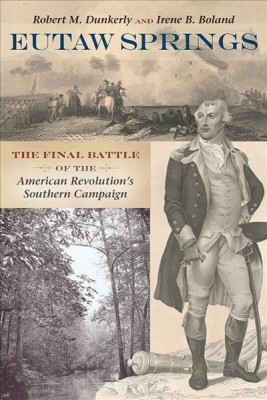| Eutaw Springs: The Final Battle of the American Revolution's Southern Campaign Contributor(s): Dunkerly, Robert M. (Author), Boland, Irene B. (Author) |
|
 |
ISBN: 1611177588 ISBN-13: 9781611177589 Publisher: University of South Carolina Press OUR PRICE: $22.79 Product Type: Paperback - Other Formats Published: May 2017 |
| Additional Information |
| BISAC Categories: - History | United States - Revolutionary Period (1775-1800) - History | Military - United States - History | United States - State & Local - South (al,ar,fl,ga,ky,la,ms,nc,sc,tn,va,wv) |
| Dewey: 973.337 |
| LCCN: 2016058019 |
| Physical Information: 0.5" H x 6" W x 8.9" (0.60 lbs) 168 pages |
| Themes: - Chronological Period - 18th Century - Geographic Orientation - South Carolina |
| Descriptions, Reviews, Etc. |
| Publisher Description: The Battle of Eutaw Springs took place on September 8, 1781, and was among the last in the War of Independence. It was brutal in its combat and reprisals, with Continental and Whig militia fighting British regulars and Loyalist regiments. Although its outcome was seemingly inconclusive, the battle, fought near present-day Eutawville, South Carolina, contained all the elements that defined the war in the South. In Eutaw Springs: The Final Battle of the American Revolution's Southern Campaign, Robert M. Dunkerly and Irene B. Boland tell the story of this lesser known and under-studied battle of the Revolutionary War's Southern Campaign. Shrouded in myth and misconception, the battle has also been overshadowed by the surrender of Yorktown. Eutaw Springs represented lost opportunities for both armies. The American forces were desperate for a victory in 1781, and Gen. Nathanael Greene finally had the ground of his own choosing. British forces under Col. Alexander Stewart were equally determined to keep a solid grip on the territory they still held in the South Carolina lowcountry. In one of the bloodiest battles of the war, both armies sustained heavy casualties with each side losing nearly 20 percent of its soldiers. Neither side won the hard-fought battle, and controversies plagued both sides in the aftermath. Dunkerly and Boland analyze the engagement and its significance within the context of the war's closing months, study the area's geology and setting, and recount the action using primary sources, aided by recent archaeology. |
Contributor Bio(s): Dunkerly, Robert M.: - Robert M. Dunkerly is a historian, award-winning author, and speaker who is actively involved in historic preservation and research. He earned a B. A. in history from St. Vincent College and an M.A. in historic preservation from Middle Tennessee State University. His research includes archaeology, colonial life, military history, and historic commemoration. Dunkerly has taught courses at Central Virginia Community College, the University of Richmond, and the Virginia Historical Society. He is currently a park ranger at Richmond National Battlefield Park.Boland, Irene: - Irene Boland (1941-2016), emeritus professor of geology at Winthrop University, held a B.A. in chemistry and biology and an M.A.T. in chemistry from Winthrop University and was a certified medical technologist. Following a rewarding career as a technologist and a medical technology instructor, Boland taught chemistry part time at Winthrop University while earning M.A. and Ph.D. degrees in geology from the University of South Carolina. As a geology professor at Winthrop, Boland received the Kinard Award for Excellence in Teaching in 2012, and in 2014 she established the Charles A. Boland and Irene Brunson Boland Student Research Assistantship Endowment. |